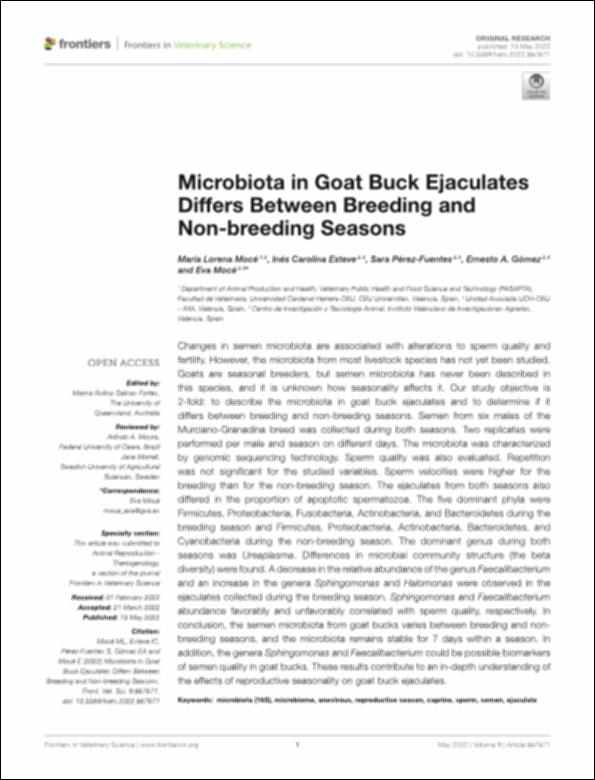Por favor, use este identificador para citar o enlazar este ítem:
http://hdl.handle.net/10637/14298Microbiota in goat buck ejaculates differs between breeding and non-breeding seasons
| Título : | Microbiota in goat buck ejaculates differs between breeding and non-breeding seasons |
| Autor : | Mocé Cervera, María Lorena Esteve, Inés Carolina Pérez Fuentes, Sara Gómez, Ernesto A. Mocé Cervera, Eva |
| Materias: | Esperma - Control de calidad.; Goats - Reproduction.; Goats - Breeding.; Cabras - Reproducción.; Cabras - Cría y explotación.; Spermatozoa - Quality control. |
| Editorial : | Frontiers Media |
| Citación : | Mocé, M. L., Esteve, I. C., Pérez-Fuentes, S., Gómez, E. A. & Mocé, E. (2022). Microbiota in goat buck ejaculates differs between breeding and non-breeding seasons. Frontiers in Veterinary Science, vol. 9, art. 867671 (13 may.). DOI: https://doi.org/10.3389/fvets.2022.867671 |
| Resumen : | Changes in semen microbiota are associated with alterations to sperm quality and fertility. However, the microbiota from most livestock species has not yet been studied. Goats are seasonal breeders, but semen microbiota has never been described in this species, and it is unknown how seasonality affects it. Our study objective is 2-fold: to describe the microbiota in goat buck ejaculates and to determine if it differs between breeding and non-breeding seasons. Semen from six males of the Murciano-Granadina breed was collected during both seasons. Two replicates were performed per male and season on different days. The microbiota was characterized by genomic sequencing technology. Sperm quality was also evaluated. Repetition was not significant for the studied variables. Sperm velocities were higher for the breeding than for the non-breeding season. The ejaculates from both seasons also differed in the proportion of apoptotic spermatozoa. The five dominant phyla were Firmicutes, Proteobacteria, Fusobacteria, Actinobacteria, and Bacteroidetes during the breeding season and Firmicutes, Proteobacteria, Actinobacteria, Bacteroidetes, and Cyanobacteria during the non-breeding season. The dominant genus during both seasons was Ureaplasma. Differences in microbial community structure (the beta diversity) were found. A decrease in the relative abundance of the genus Faecalibacterium and an increase in the genera Sphingomonas and Halomonas were observed in the ejaculates collected during the breeding season. Sphingomonas and Faecalibacterium abundance favorably and unfavorably correlated with sperm quality, respectively. In conclusion, the semen microbiota from goat bucks varies between breeding and nonbreeding seasons, and the microbiota remains stable for 7 days within a season. In addition, the genera Sphingomonas and Faecalibacterium could be possible biomarkers of semen quality in goat bucks. These results contribute to an in-depth understanding of the effects of reproductive seasonality on goat buck ejaculates. |
| Descripción : | Este artículo se encuentra disponible en la página web de la revista en la siguiente URL: https://www.frontiersin.org/articles/10.3389/fvets.2022.867671/full Este artículo de investigación pertenece a la sección "Animal Reproduction - Theriogenology". |
| URI : | http://hdl.handle.net/10637/14298 |
| Derechos: | http://creativecommons.org/licenses/by/4.0/deed.es |
| ISSN : | 2297-1769 (Electrónico) |
| Fecha de publicación : | 13-may-2022 |
| Centro : | Universidad Cardenal Herrera-CEU |
| Aparece en las colecciones: | Dpto. Producción y Sanidad Animal, Salud Pública Veterinaria y Ciencia y Tecnología de los Alimentos |
Los ítems de DSpace están protegidos por copyright, con todos los derechos reservados, a menos que se indique lo contrario.


